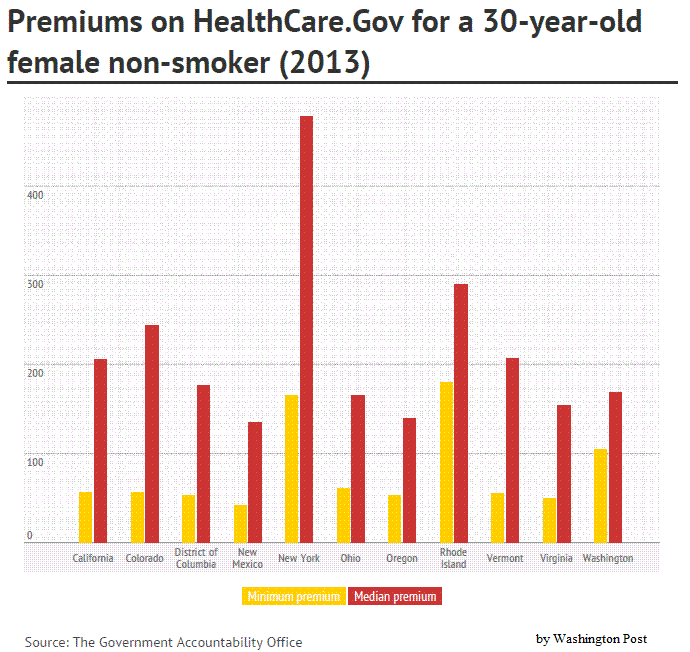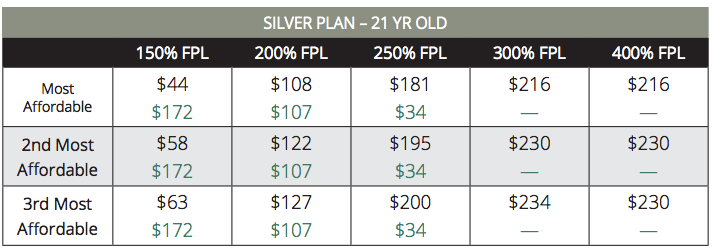Our data on health premiums has been pretty bad. Not anymore.
By Sarah Kliff, July 24, 2013 - Washington Post
Get excited health-care world: I think Ifve found my new
favorite Government Accountability Office report, perhaps the most
scintillating of their works since gStatus
of CMS Efforts to Establish Federally Facilitated Health Insurance
Exchanges,h which was, admittedly, also a page-turner.
The report came at the request of Sen. Orrin Hatch, a Republican who
represents Utah. He wanted to know how much health insurance costs right this
moment, which could help us better understand how the marketplace will change
with the Affordable Care Act.
On Monday, the Government Accountability Office sent back a thick stack of
insurance data, broken down by state, explaining the cost of health insurance.
Analysts there used data from HealthCare.Gov, a new site created under the
Affordable Care Act where insurers post their offerings and how much they
cost.
The database, the GAO analysts admit, isnft perfect. About 20 percent of
insurers donft post their plan data, which means wefre missing about one-fifth
of the marketplace. Therefs no enrollment data, which means some of the options
listed may not have any subscribers.
Still, this is probably the best data set we have on insurance premiums so
far. Itfs also a dense report, 62 pages of line-by-line data that Ifve found a
bit easier to digest in a chart.
What you see below are premiums from 10 states and the District of Columbia
for a 30-year-old female who does not smoke and has not yet been underwritten
(read: She could face a higher charge, if she has a preexisting condition).
I chose these states because these are the ones
that Health and Human Services used in its report last week, which looked at
premiums under the Affordable Care Act. As for the demographic element, the GAO
only broke out data for certain types of insurance subscribers. I picked out
one, but you can see the rest in the full report.
Without further ado, herefs what premiums look like right now for a young
woman purchasing her own health insurance coverage:

A few things stood out to me here.
Some young, healthy adults can buy really cheap insurance right
now. In most states, a 30-year-old without preexisting conditions
can purchase a health insurance plan for about $55. New Yorkfs premiums are a
notable exception to this for reasons explained here. Washington and Rhode
Island Ifm less familiar with and not quite sure why their premiums are so much
higher than the rest.
But not all of them: One in five applicants on HealthCare.Gov are
rejected. The data you see before is all before underwriting, where
insurers figure out the amount they should actually charge a
subscriber –– or if they even want to insure that person in the first place. A
separate GAO
study found that 19 percent of applicants for coverage on HealthCare.Gov are
rejected by the insurance company. With some plans, the number is as high as 70
percent.
That coverage will be really
skimpy. The majority of those plans in the $50-range have a
deductible of $10,000. Vermontfs $55 offering has an impressively
large $100,000 deductible (no, that last zero is not a typo).
This is something that will be very different under the Affordable Care Act,
where cost sharing for an individual (not just the deductible, but all the
co-pays too) is limited to about $6,000. Therefs a debate over whether this is a
good thing; some argue that this forces young adults to buy coverage more robust
than what they need. But what both sides do agree on is that plans sold on the
new marketplaces will be more robust than whatfs on the market right now.
Some young adults will still get insurance for $55 under Obamacare.
Some wonft. It all depends on their income level, which determines
the level of subsidies that an individual receives. California, for example,
estimates that a young adult at 150 percent of the federal poverty line would be
able to purchase a health plan for $44 per month:

A 21-year-old who received no subsidy at all, by contrast, would face a $172
premium for the same insurance plan.
Itfs still hard to compare premiums pre- Obamacare and
afterward. Youfll notice that the numbers in my chart are significantly
lower than those in HHSfs
estimates of average premiums under Obamacare. I would caution against
reading too much into that.
Part of the difference is undoubtedly due to the Affordable Care Act:
Premiums increase when sick people enter the market, and policies are required
to cover more benefits. But another part of it is a less sexy issue of data
formatting that makes the HHS and GAO data a bit of an apples-to-oranges
situation. The HHS data are capturing both Obamacare policies and the cost of
insuring older adults, and any comparisons to the GAO figures should probably be
made with a massive grain of salt.
KLIFF NOTES: Top health policy reads from
around the Web.
Hospitals are gearing up for a big Obamacare push. gBig
chains, publicly owned safety-net facilities and local hospitals are ramping up
their efforts to be ready for the six-month open enrollment period for 2014
health insurance that begins Oct. 1, when the health insurance exchanges for
people who donft get health benefits at work are due to open for business. How
well they do could go a long way to determining the success of Obamacarefs first
year.h Jeff
Young in the Huffington Post.
Congratulations Wisconsin and Virignia, youfre the lowest Obamacare
spenders! gOnly one state will spend less per capita than Virginia
to promote public awareness of the new health care reform law. According to
data compiled by The Associated Press from federal and state sources, the $3.9
million in outreach spending in Virginia amounts to 49 cents per resident. Only
Wisconsin, at 46 cents, is spending less per capita.h The
Associated Press.
Of course Oregonfs fight over Obamacare is being fought withcacoustic
guitars. gBen Nanke, a 20-year-old aspiring songwriter and
filmmaker from Salem, admires the musicality of the hCover Oregonh ads
promoting the statefs new health care exchange. But Nanke, a registered
Republican and self-described libertarian, doesnft think much of Obamacare, or
any government-run health care for that matter. So with some friends, he created
his own music video championing the virtues of rugged individualism.h